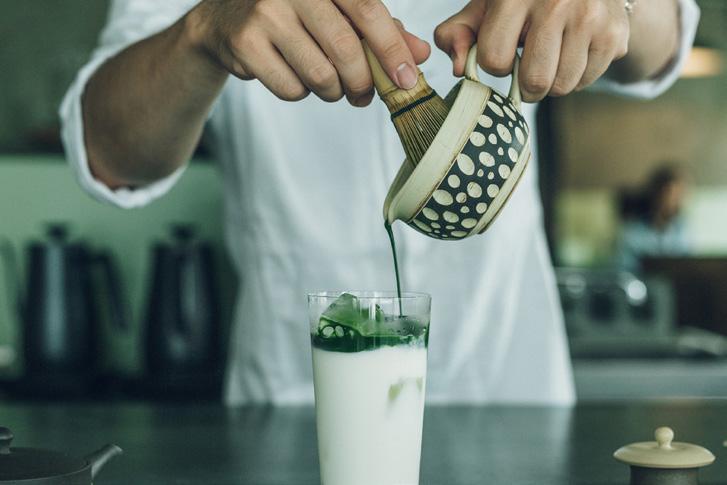
23 minute read
Another 3hr Trip - How to Make the Best of 3 Hours in Tokyo
Although Japanese tearooms are the fi rst things to spring to mind when people think of green tea, there are plenty of other places where you can enjoy the wonderful fl avor of matcha, often in new ways that you may not have thought possible! Whether you want matcha confectioneries, tea leaves or a new take on cakes and snacks, you’re sure to fi nd something to suit you!
▼ keep reading here: ▶
Advertisement
WTT35 green tea
Scan QR code for more information
Cafés
Satén Japanese tea


Satén Japanese tea is a modern-style teahouse that specializes in Japanese tea, with ingredients sourced from Japanese tea farms across the country. Satén’s specialty is matcha latte, and its wildly popular green tea pudding, but they also off er plenty of other products, such as single-origin Japanese tea. The interior is simple yet stylish and makes Satén a wonderful blend of traditional and contemporary design.
SALON Nihonbashi Store
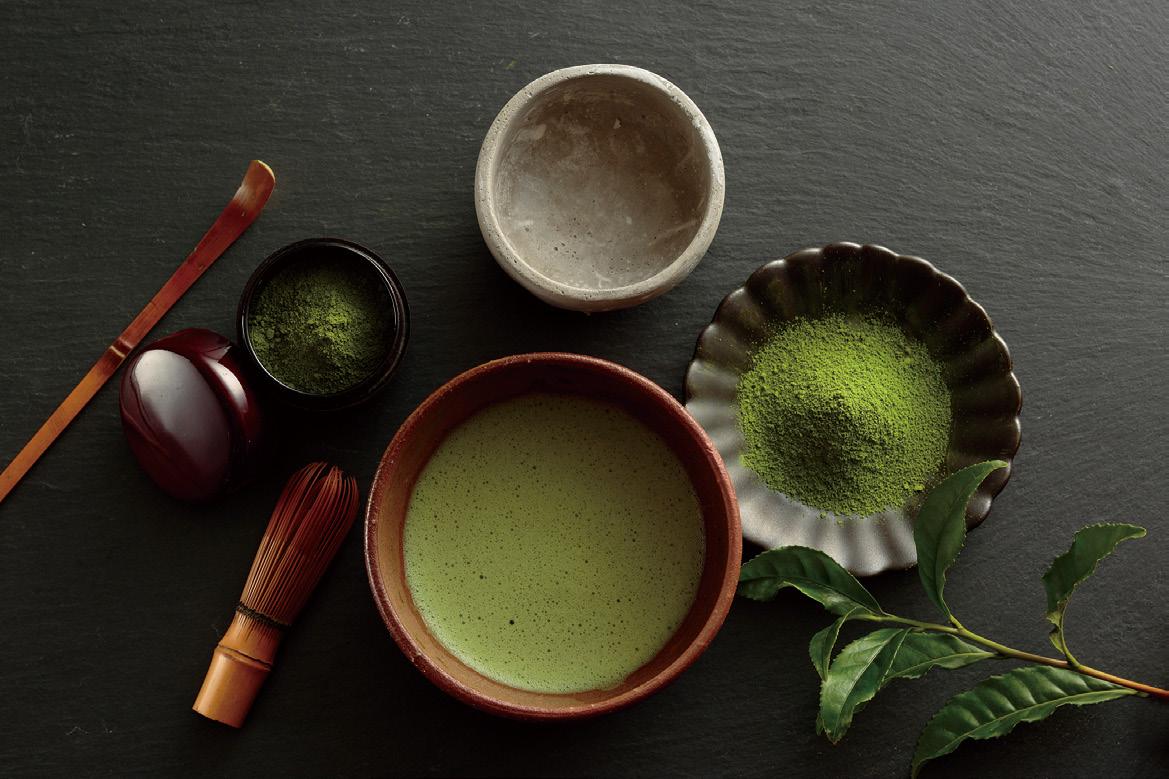
SALON is a shop where you can fi nd Teicha (matcha served with Japanese sweets) and learning courses of tea-making (currently in Japanese only). For those who want to try it at home, they sell a wide range of tea-making utensils and beautifully designed wooden boxes. When you order Teicha, you can also opt to make matcha by yourself with kind assist by the store staff . They off er delicious original blended matcha and beautiful Japanese sweets specially delivered from Nara.

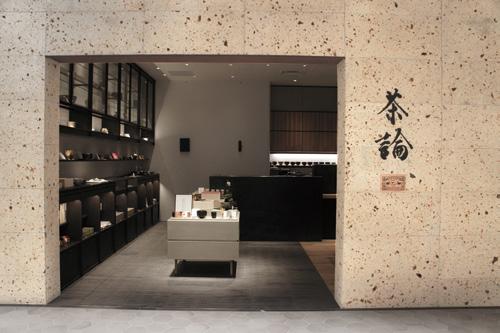
THE MATCHA TOKYO Omotesando


THE MATCHA TOKYO Omotesando is a shop that only uses 100% organic matcha sourced from places like Kyoto Uji or Kagoshima and worked by a tea master to create a light, wonderful taste. It off ers a huge variety of products, including delicious ice cream and dairy-free options such as soy or almond milk lattes. The shop has a pleasant, modern feel to it, and visitors are sure to enjoy their stay.
NAKAMURA TOKICHI HONTEN Ginza Store


NAKAMURA TOKICHI HONTEN Ginza Store has come up with several kinds of matcha-fl avored confectionery, including ice cream, jelly, and parfait. The most popular dessert is Namacha Zerii, which consists of matcha jelly and ice cream, black soybeans, chestnuts and a special matcha bean jam, which is only available at its Ginza Store. You can also buy the special Namacha Zerii with matcha bean jam, Matcha Financier (small almond cake made with matcha) and more to enjoy at home.
Ginza Kazuya
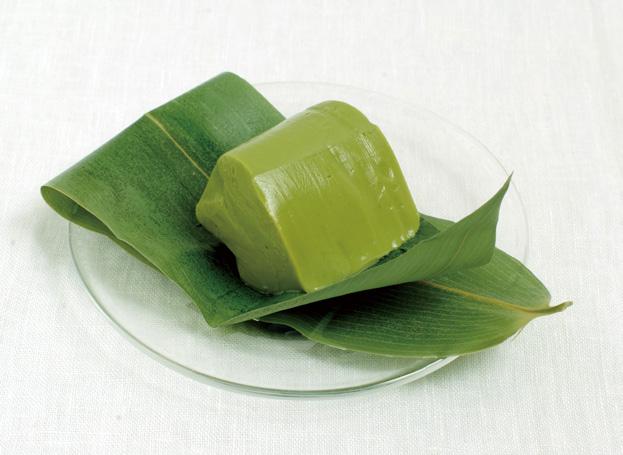

Anyone who wants proof that good things come in small packages need to look no further than Ginza Kazuya, which is arguably one of the smallest shops in Tokyo. The owner has perfected his recipe for nerigashi (its original sweets with the food texture like jelly) and matcha-fl avored treats. Every step of the creative process is done by hand, and this shop also off ers sweets that are unique to Ginza Kazuya.
Shimokita-chaen Oyama
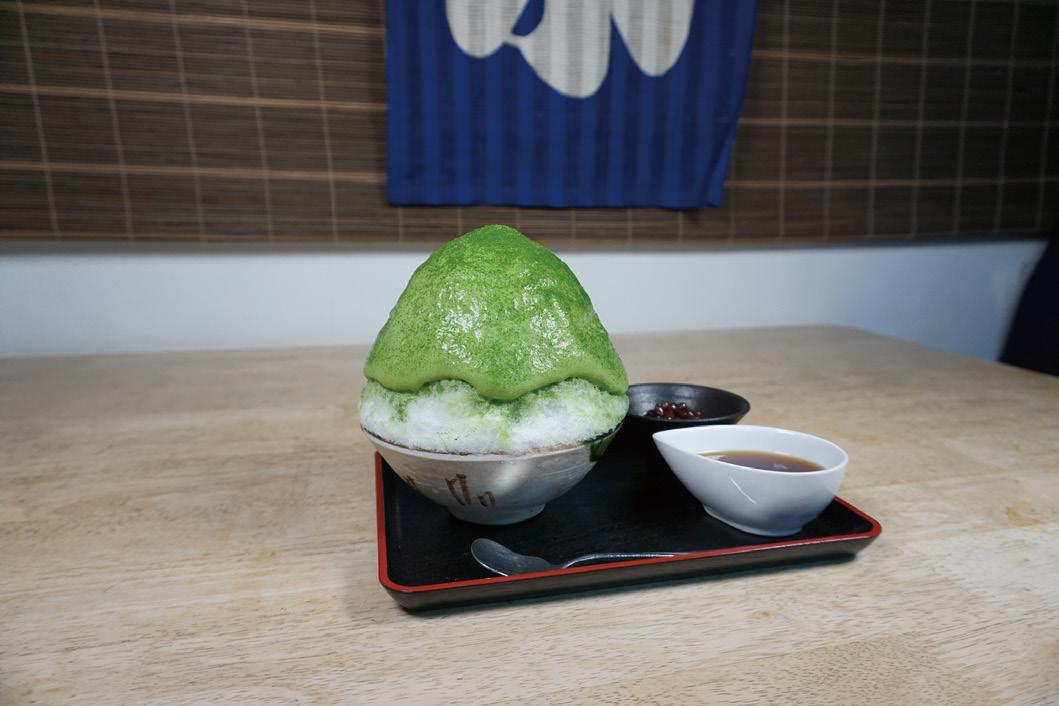
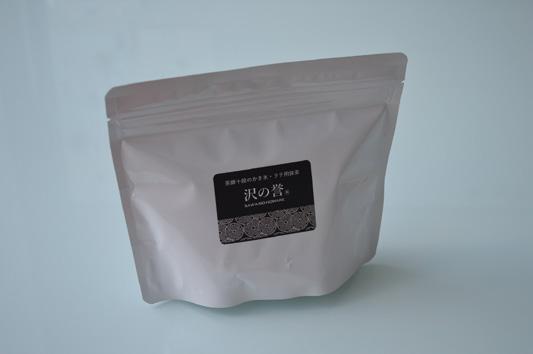
If you want to try making matcha at home, then Shimokita-chaen Oyama is the place for you. This shop has a qualifi ed tea master and sells tea leaves and matcha along with delicious, matcha-fl avored shaved ice made fresh every day. The most popular one is Bito Matcha Kakigori (shaved ice with low sugar matcha syrup), made using fi ne matcha from Kyoto Uji available at the shop and espuma, which is a fl uff y, mousse-like syrup that gives this dessert a wonderfully light texture.
pâtisserie Sadaharu AOKI paris Marunouchi
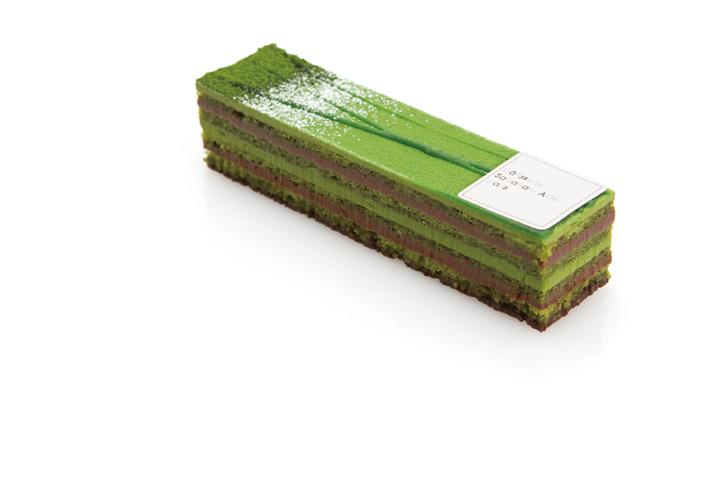
Japanese famous pâtissier Sadaharu Aoki already has fi ve pâtisseries in Paris, and fi ve in Japan including the Marunouchi store , where there’s a wide range of diff erent cakes, from eclairs to macarons, to croissants and many other delicacies to tempt you. One of Sadaharu Aoki’s trademarks is using matcha to fl avor his creations, resulting in Bamboo (photo on the left) or Éclair Mâcha for a true East-meetsWest confectionery experience.
PÂTISSERIE FRANÇAISE Tadashi YANAGI Yakumo Store

People with a sweet tooth will be spoiled for choice at Tadashi YANAGI Yakumo Store. The pâtissier, Yanagi Tadashi, studied in Paris and has won numerous awards for his skill, and was juror and Japan’s team leader for the Coupe du Monde (World Cup). In addition to creating a plethora of delicacies for customers, the shop also uses matcha in pound-cake — Le Kiichi — and even mini-pound cake!
Tea leaf shops
Cha no Kiminoen
Cha no Kiminoen has been in the Japanese tea business for over 90 years. It sells a variety of tea leaves and matcha, with special emphasis on those from Shizuoka, Kagoshima or Kyoto Uji. If the leaves and matcha aren’t enough to quench your thirst for matcha-related items, the shop also sells Japanese teapots and other tea utensils, along with a delicious matcha ice cream.
Suzukien

Suzukien has been in the tea business for over 150 years, and sells tea leaves and matcha from all over Japan, with friendly, knowledgeable staff to help you select the perfect blend for your tastes and needs. There are seven diff erent intensities of matcha gelato available here, but the most famous is the Premium No. 7 gelato, which has been certifi ed as the gelato with the world’s highest matcha content!
Although Kagurazaka is close to Tokyo’s entertainment district, Shinjuku, it has a character all of its own. As a prominent hanamachi (geisha district) that thrived from the Edo Period (1603-1868) to the Showa Period (1926-1989), Kagurazaka is well-known for its refined, nostalgic atmosphere. Venture inside the cobbled alleys and you will discover tons of historic geisha houses and sophisticated shops that embody the Japanese aesthetic sense and precise craftsmanship.

神 楽 坂

FUJIYA Iidabashi Kagurazaka Shop 不二家飯田橋神楽坂店 Fujiya is a hundred-year-old cake shop chain famous for their strawberry cake. Most Japanese consider the shop’s mascot, Peko-chan, as part of their childhood memories. At the Kagurazaka shop, you can get your hands on the shop’s original Peko-chanyaki, a traditional Japanese baked cake that comes with a variety of fillings and take a photogenic picture of the scrumptious filling oozing out of the freshly baked dough.
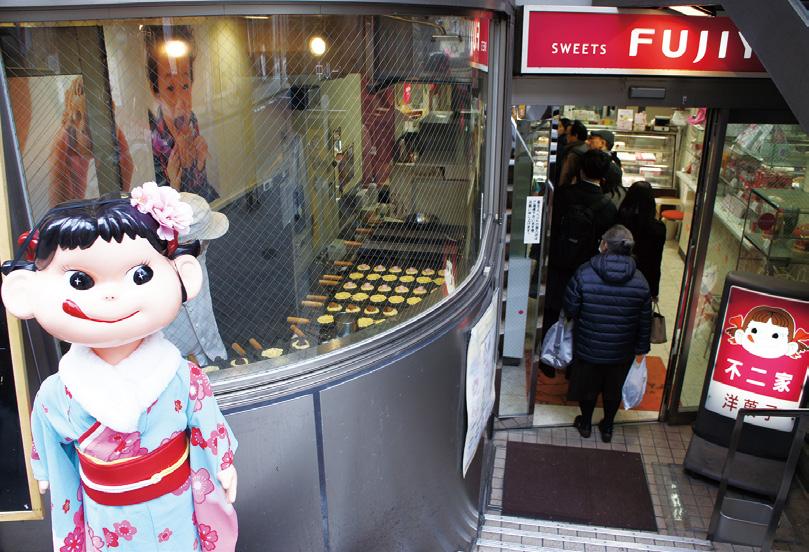

Japanese Pottery Shop YOULUCK 神楽坂佑楽 When you turn from Kagurazaka Street to the back ally, a totally different world appears before your eyes. The Kagura path has a nostalgic atmosphere, and you can escape from the bustle of Tokyo for a while. Here, there is a specialty shop named “YOULUCK”, which specializes in Japanese pottery selected carefully from all over Japan. Because all the works in the shop are handmade, each one has different texture, color and expression. The work is not only for appreciation but can enrich your daily life as well.

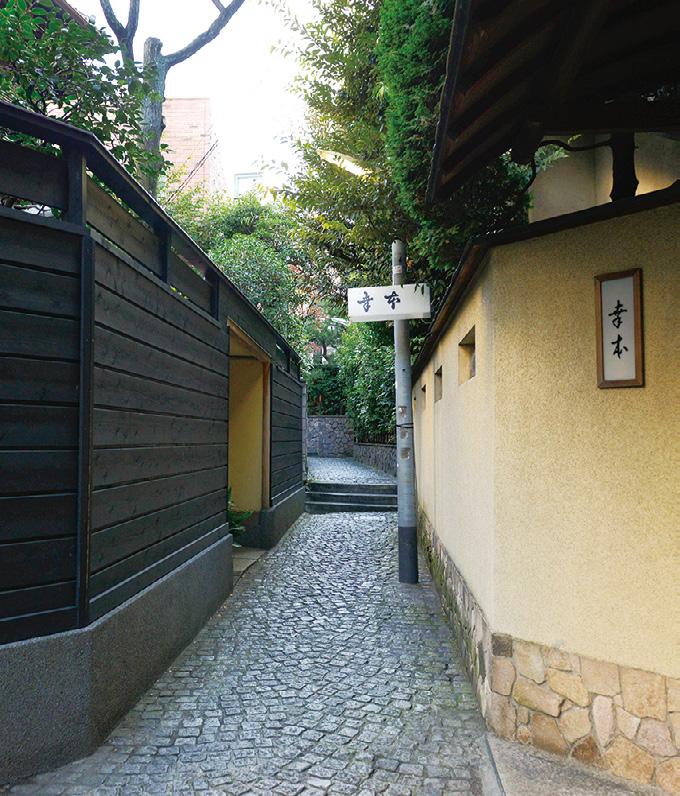
Hyogo Yokocho Alley 兵庫横丁 Hyogo Yokocho is an atmospheric, stonepaved alley packed with Japanese restaurants and hotels that will take you back in time. The area used to be a storage area for arsenals in the past, so the word hyogo (arsenal in Japanese) is in its name.
English explanation support from the staff, local hotel and overseas delivery service of products are also available. So, no worries about baggage. Buy a Japanese pottery full of charm and it will remind you of the memories in Japan.
Baikatei 梅花亭 Established over 80 years ago, this beloved Japanese confectionery shop offers a line of traditional sweets made using 23 types of handmade sweet bean fillings. These incredible fillings follow meticulous and painstaking recipes that detail the amount of beans, sugar, and condiments that go into each blend. Visitors can take a peek at the amazing skills of the pastry chefs through the shop window.
Kagurazaka Station

UshigomeKagurazaka Station Tokyo Metro Tozai Line

Toei Oedo Line
AREA MAP
Iidabashi Station
Tokyo Metro Namboku Line JR Chuo / Sobu Line
Juttoku. ジュットク Japanese incense has a long history and rich culture. Fragrant wood, such as camphor and cedar, are processed into powder before adding an assortment of herbal ingredients. It is then molded into different shapes for different purposes. Burning the incense releases a gentle, natural fragrance that creates a warm, relaxing ambience. This incense specialty shop runs a press incense/incense sachet DIY workshop for beginners.


Zenkokuji Temple 善国寺 This 400-year-old temple was moved to the current location only some 200 years ago to look after Kagurazaka’s neighborhood, which was a residential area for samurai at first. Later on, the community grew to include a variety of shops and geisha houses. Pay a visit to Zenkokuji Temple to enjoy its architectural splendor and experience the precious heritage of Kagurazaka.


NOREN MURO Kagurazaka のレン MURO 神楽坂店 Kagurazaka functioned as a trade hub for rice, miso, soy sauce, and many other goods in the past because of its close proximity to a cargo handling center. Inspired by this history, the shop was established to introduce the splendor of some Japanese condiments like koji, a fungus used to ferment soybeans. Food lovers will definitely see shopping here as a fun treasure hunt.
J a p a n e s e Po t t e ry Sh o p
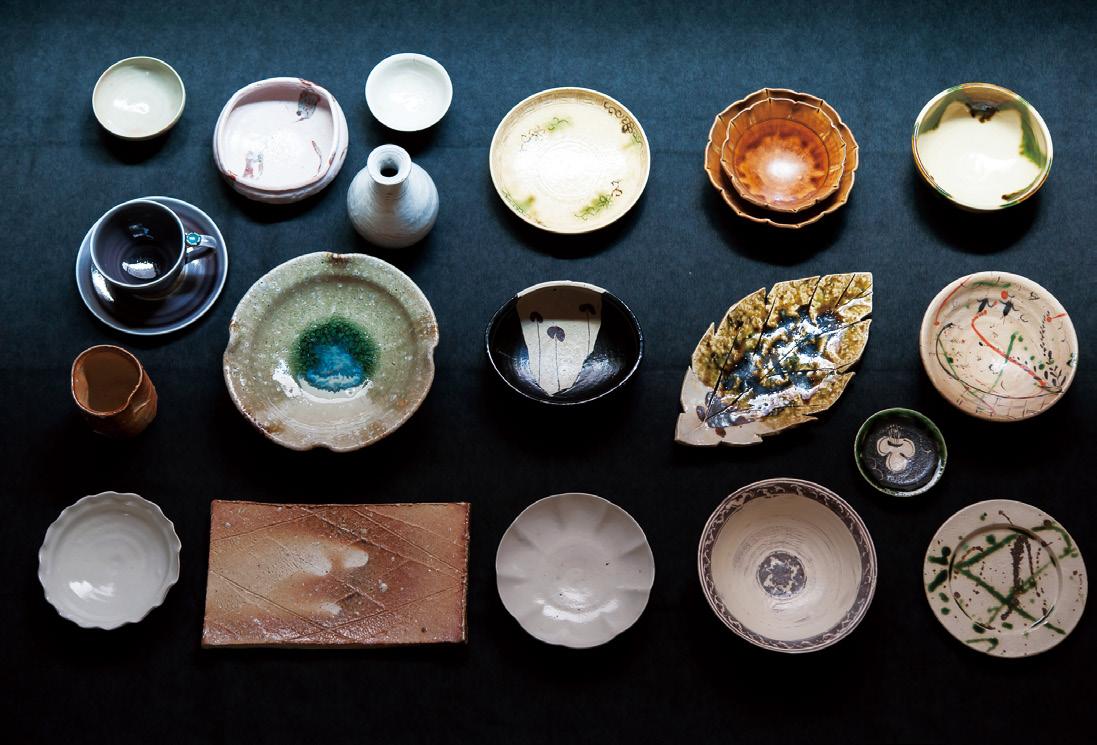
H a n d m a d e p i e c e s o f c u l t u r e , e n c a p s u l a t i n g t h e s p i r i t o f w a b i - s a b i

This Japanese pottery shop features amazing handmade items fired in traditional kilns, available especially in Kagurazaka, an area steeped in classic Japanese atmosphere. These ceramic souvenirs will be your best memories from Japan!
2-10 Kagurazaka, Shinjuku-ku, Tokyo, 162-0825, Japan
81-(0)3-6228-1178 uluck.jp/en/ @kagurazakauluck
3HR ANOTHER TRIP ASA
K U S A Around Tokyo in 180 minutes
浅草
Situated in Asakusa, Sensoji is an attraction that paints a perfect picture of what the bustling streets of Tokyo’s old town area were like during the Edo period. Chonin, a class of townsmen including merchants, craftsmen, and artisans who emerged during this time, are still very active today and play an influential role in local businesses. Aside from Tokyo’s kitchenware capital Kappa-bashi and other shopping streets, there are also several historic gourmet destinations to keep you occupied. Asakusa Culture and Tourism Center 浅草文化観光センター

A tourist information center located inside a unique building in front of the Asakusa Kaminarimon Gate. The building is the work of Kengo Kuma, one of the bestknown Japanese architects. The ceiling and the interior are quite interesting so don’t even consider skipping it. The night view of Asakusa from the observatory on the 8 th floor’s terrace is also highly recommended.
Asakusa Tatsumiya 浅草たつみや With an 80-year history, the kimono shop Asakusa Tatsumiya never fails to keep up with the latest trends. Its third generation owner has been incorporating Japanese kimono sashes into tumblers, cushions, centerpiece, and a wide range of goods. With these ingenious souvenirs, you can easily bring home the beauty of a kimono. Do drop in if you are looking for something unique and authentic!


Waentei-Kikko 和えん亭 吉幸 Located in the vicinity of Sensoji, Waentei-Kikko is a haven where you can enjoy traditional Japanese haute cuisine. Lovers of music, prepared to be charmed by the owner’s live Tsugarushamisen (a three-string instrument) performance, which always adds a touch of magic to the atmosphere. Experience authentic Japanese hospitality and culture right here.

Sensoji Temple 浅草寺 Sensoji is a temple with 1,400 years of history and a must-visit for any traveler to Tokyo. The symbolic Kaminarimon (Thunder Gate) leading to the temple appeared about 1,000 years ago when it was built along with other major structures in the complex. While here, don’t forget to stroll down the 200-meter thriving shopping street, Nakamise, for an adventure of food and culture.
Scan the QR code for more information about the featured places in Asakusa
Asakusa Station
TSUKUBA EXPRESS Asakusa Rokku Street
Kaminarimon Street Sumidagawa River TOBU SKYTREE Line
Asakusa Station
Denbouin-dori 伝法院通り
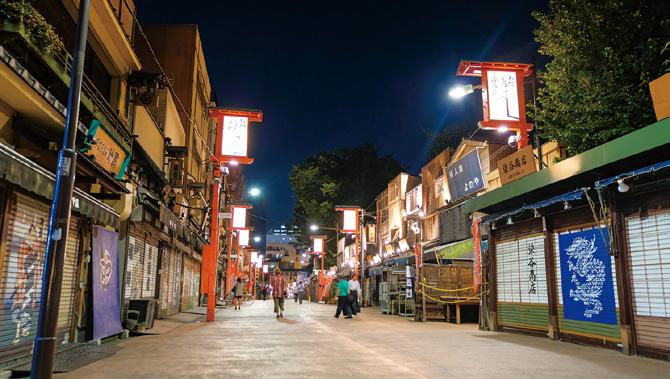

With a plethora of retro shops selling crafts and accessories, Denbouin-dori is a great place to experience the culture and atmosphere of Edo. Not only are the shutters decorated with Edo-style paintings, but also shop roofs all have traditional Japanese tiles and the wooden billboards are written in Japanese calligraphy. Denbouin-dori will surely satisfy the cultural curiosity of tourists. AD_3HRS_KAMATA_TKY31.pdf 1 2019/02/06 15:38:31
CHAGOHAN TOKYO 茶御飯東京 No one would disagree that Japanese cuisine is among the best in the world. Chagohan is now offering spectacular cooking courses for those interested in learning the secrets to making delicious classic Japanese dishes, such as sushi, sukiyaki, katsudon, and more. You can also sign up for vegetarian courses, sake tasting classes, and tea ceremony sessions to gain a deeper insight into Japanese dining.
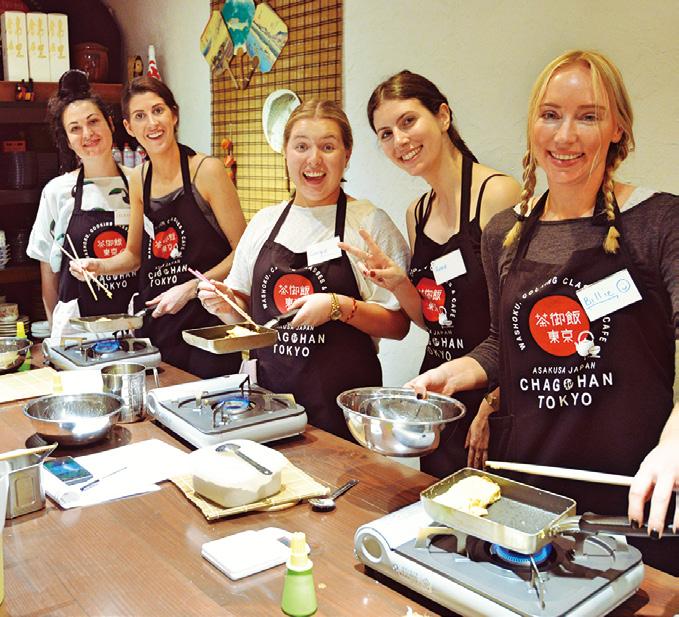
KAMATA HAKENSHA かまた刃研社

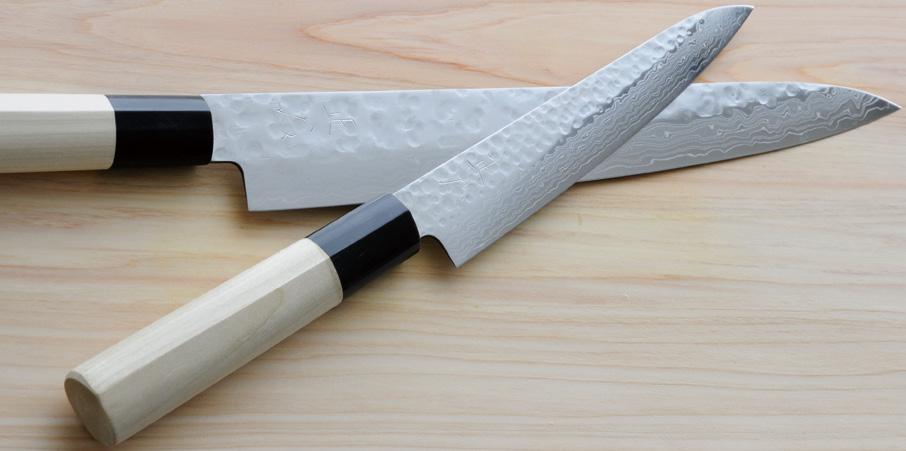
Kamata Hakensha has been serving the neighborhood for over 90 years and has earned a reputation for selling quality Japanese knives and being able to breathe life back into any knife. While many tourists come with a mission to find the right knife for themselves or friends, others come to have their old knives maintained. As the saying goes, to do a good job, one must first sharpen one’s tools. Find out the criteria for a good knife from the knife masters at Kamata Hakensha.
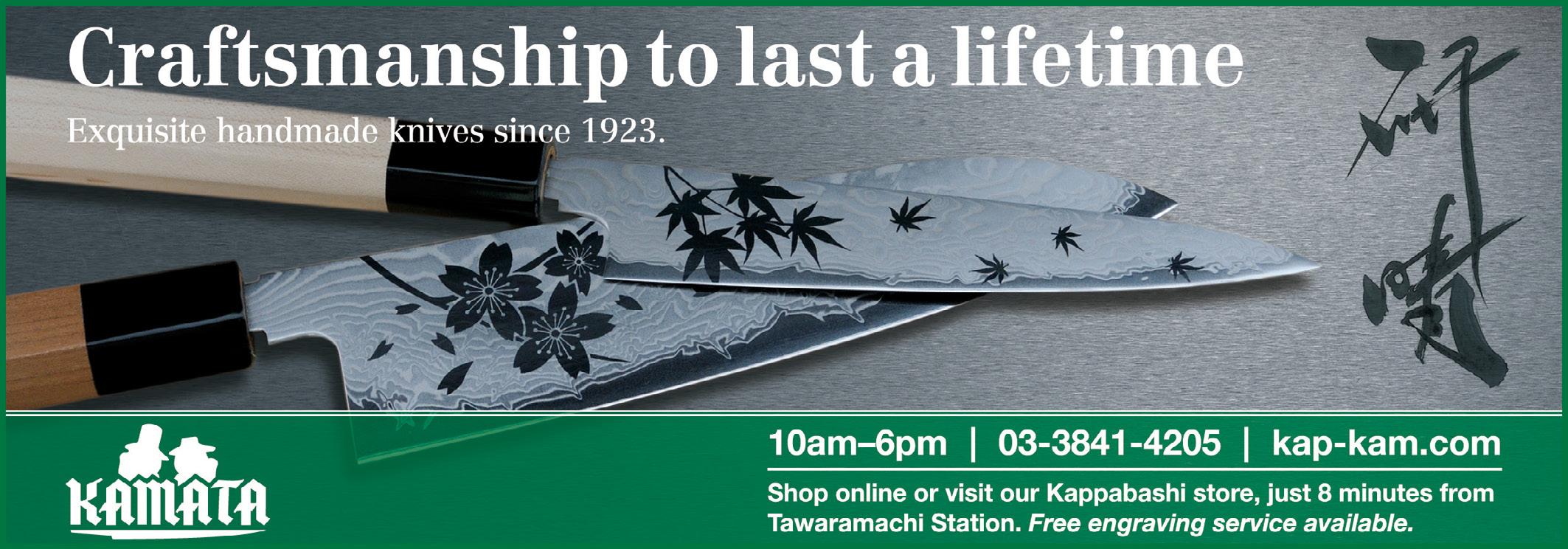

Tokyo Station, conveniently located at the heart of the capital, is Tokyo’s gateway to destinations all over Japan. Some say that the station is too big and confusing for fi rst timers. But once you get the directions right, you can defi nitely get the most out of your time here. Tokyo Station off ers an extraordinary range of cuisine and impressive attractions that tie the modern with the past.
キッテ ・ 丸ノ内 KITTE Marunouchi Located next to Tokyo Station, JP Tower KITTE is a renovation of the former Tokyo Central Post Offi ce. After opening in 2013, the shopping complex has become one of the most popular attractions for foreign visitors. KITTE means postage stamp in Japanese and represents the expression of greeting and wishes for happiness. Many tenant shops sell limited-edition goods inspired by postage stamps. The outdoor garden on the 6th fl oor has a gorgeous view of the city both during the day and in the evening.
The museum rests at the corner of this spot!


Quack, Honk, and Whoop - Ducks and Swans wade along this point too!

三菱一号館美術館

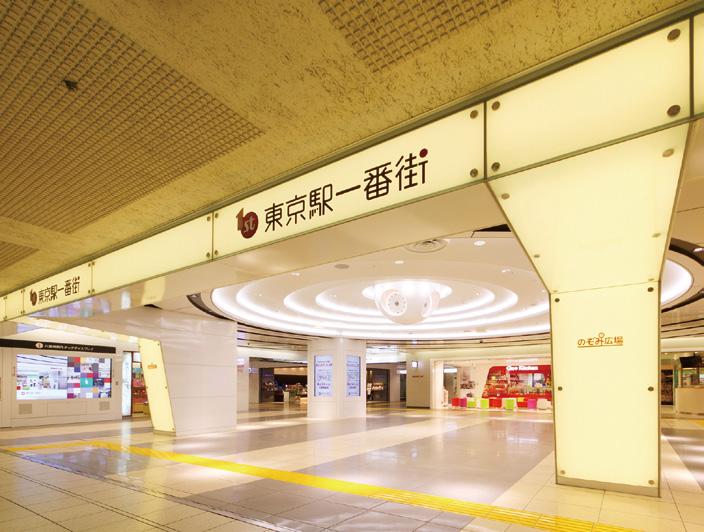
東京駅一番街 Mitsubishi Ichigokan Museum, Tokyo First Avenue Tokyo Station The Museum is a restoration of the old Mitsubishi Ichigokan built in 1894. The western building adds a tinge of nostalgia to central Tokyo’s modern ambiance. After appreciating the masterpieces of 19th century artists, have a cup of coff ee at Café 1894, where its high-rise ceiling reveals the glamour of the original banking hall during the Meiji Period. The café is not only sought after by tourists but also TV drama producers so enchanted by it that they select it for their shooting location. First Avenue Tokyo Station is an underground shopping center you cannot miss. Tokyo Character Street, Tokyo Okashi Land and Tokyo Ramen Street off er animation fi gurines, local delicacies and souvenir gifts to bring home. If time is on your side, line up for a bowl of hot ramen noodles to reward yourself at the end of the day. 皇居二重橋 Kokyo Nijubashi (Tokyo Imperial Palace) The bridge connects high-rise buildings in the Marunouchi area with a large plaza in front of the Imperial Palace. The plaza, also called Kokyogaien in Japanese, used to be the residence of important offi cials in the Edo period. The stone bridge is called Nijubashi in Japanese because it used to have two levels. The sight of bridges, green grass and black pine trees is as picturesque as it gets. Enjoy a peace of mind here where time seems to come to a halt. Otemachi Station
Tokyo Station Nijubashimae Station AREA MAP Scan the QR code for more information about the featured places near Tokyo
SHINAGAWA STATION 品川駅
Shinagawa Station, known as the gateway to Shinkansen (bullet train) and Haneda Airport, is the fi rst post station on the Tokaido Road, an important road connecting Tokyo and Kyoto in the Edo period. Back then, it thrived as a post station town, or shokuba-machi in Japanese. You can still fi nd some remnants of the good old Edo about 10 minutes away from the high-rise buildings in front of the Shinagawa Station.
Scan the QR code for more information about the featured places near Tokyo Kitashinagawa Station
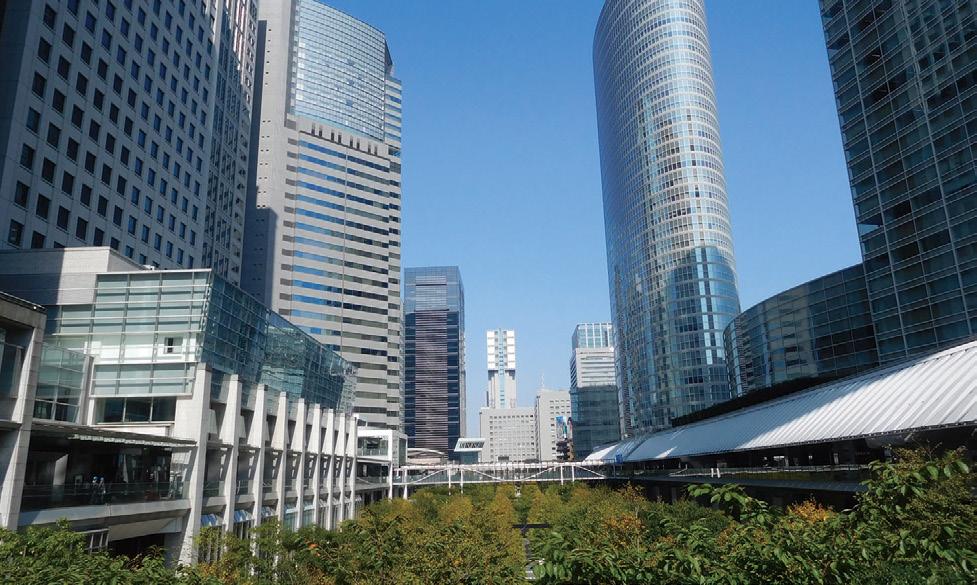
品川宿 Shinagawa Post Station On the north side of Shinagawaura-no-funadamari is the old Shinagawa post station, which was illustrated by the famous Japanese ukiyo-e artist Utagawa Hiroshige. The post station town, measuring two kilometers in length, has a shopping street that dates back to the Edo period. Since the area was not destroyed in the Great Kanto Earthquake of 1923 nor World War II, most of the buildings have a story to tell. You can still see traditional stores selling fi sh, sushi, tempura and daily goods. Oiran parade is held at the end of September every year, so don’t miss this chance to see a real life geisha.
Shimbamba Station
「八ツ山橋」から「品川浦の舟だまり」 From Yatsuyamabashi to Shinagawaura-no-funadamari Go out from JR Shinagawa Station West Exit, walk along Dai-ichi Keihin and you will come across a pedestrian bridge called Yatsuyamabashi. This is where Godzilla fi rst stepped onto Tokyo’s soil in the famous Japanese movie, Godzilla! Modern buildings crowd the scene from the station all the way up to here, but onward is Shinagawaura, a small fi shing village on Tokyo Bay. You can still see beautiful wooden houses that line the street here. Stand on the bridge and you will be greeted by traditional Japanese boats. Look behind you and you see high-rise buildings—what a contrast!

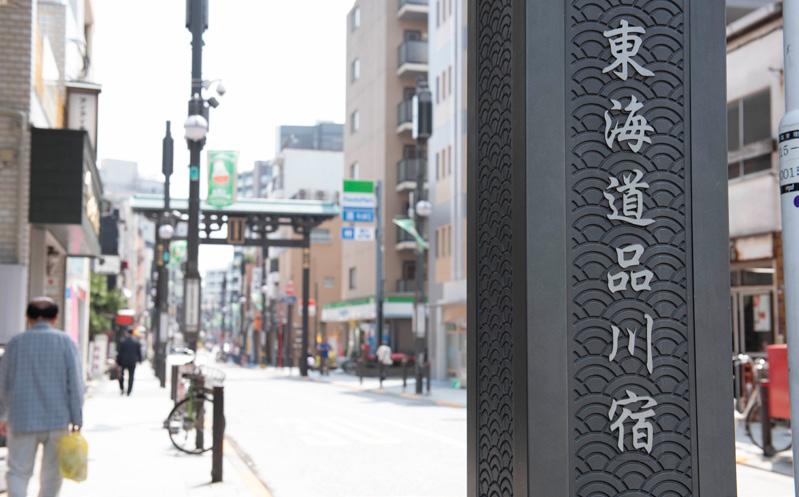
品川神社 Shinagawa Shrine Go past the old Tokaido Road, make a right turn for Dai-ichi Keihin and you will see a gigantic Torii gate, along with a steep stone stairway. The shrine had deep ties with the Tokugawa Shogunate. Besides laying eyes on the bold dragon carved into the torii gate, as well as the impressive architecture, you do not want to miss Fujizuka. This small mound is a miniature Mt Fuji made in the Edo period for those who were unable to climb it in person. The top of Fujizuka grants a fantastic view of Shinagawa’s skyline. Next to the hall of worship is Ana-inari Shrine, where you can see a torii gate extending before you.

品川宿交流館 本宿お休み処 Shinagawajuku-koryukan
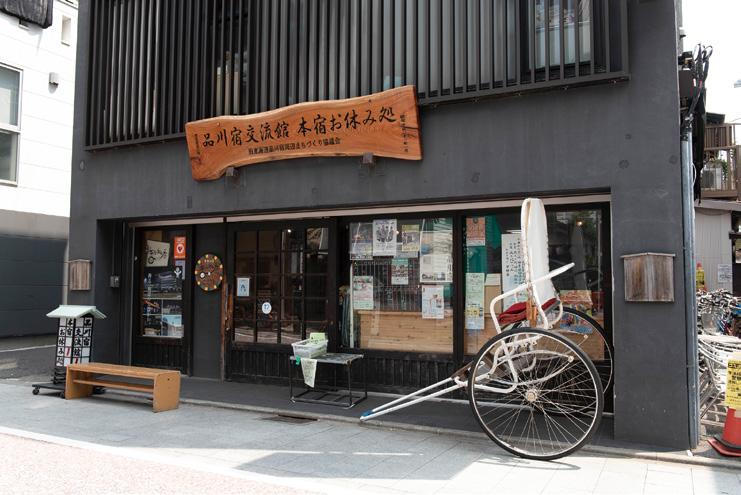
Treading along with the historic Shinagawa-esque cityscape stands the Shinagawajuku-koryukan. The place functions both as a tourist center and a humble gallery; local art works are exhibited within. In addition to these, the ground fl oor also houses a dainty pop-and-mom store - Japanese sweets since the olden days are sure to pique the interest of sightseers! Stop by this spot before heading out past Shinagawajuku!
21WAttention Tokyo |
B ASHI 3 HR ANOTHER TRIP NIHON Around Tokyo in 180 minutes 日本橋
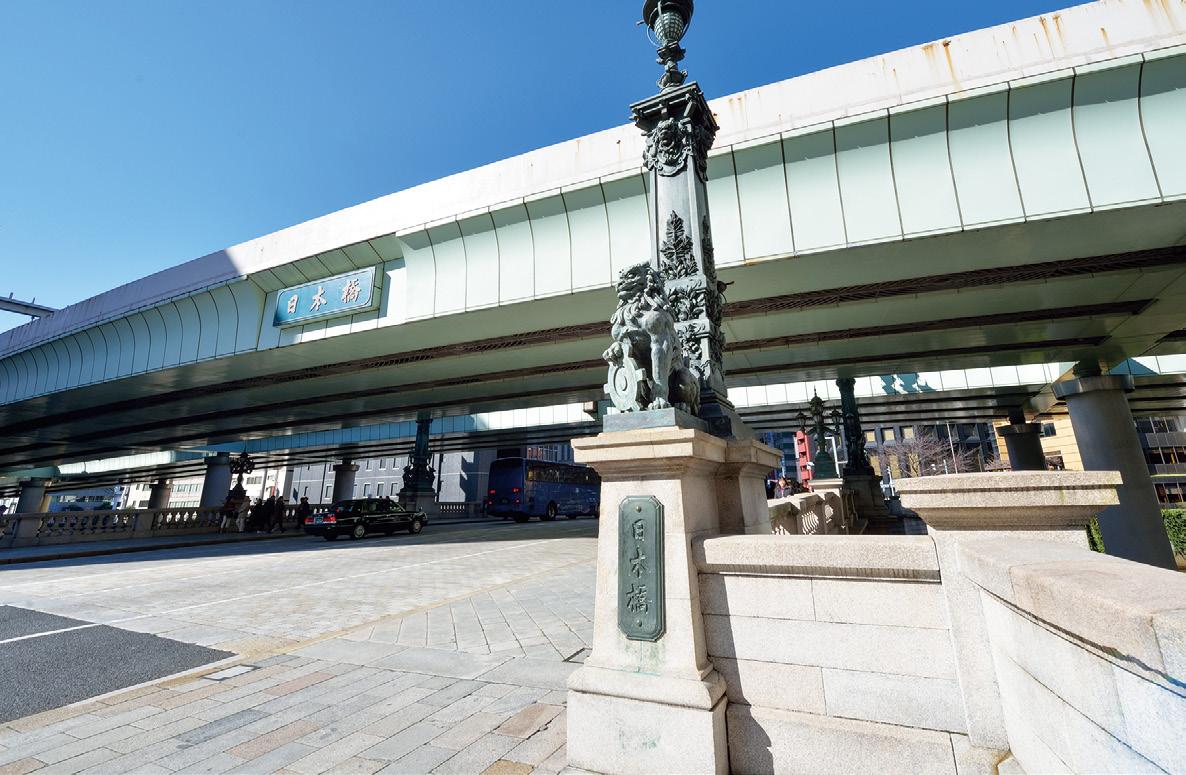
The Nihonbashi area grew extremely fast following the beginning of the bakufu in the Edo period (1603-1868). The old castle town became the starting point for five major highways connecting the capital with other areas of Japan and a prosperous hub for businessmen, artisans and shops due to large amounts of people passing through. A trip to Nihonbashi will take you back in time to discover century old establishments that strive to preserve tradition, as well as advance with the times.

Nihonbashi Information Center 日本橋案内所
Speak to the multilingual concierges here to get insider tips on where best to shop, eat, and sightsee to make the utmost of your Nihonbashi visit. The souvenir shop here stocks everything from food to historical shops in the area to modern accessories inspired by Edo chic. International concierges also lead a variety of tours and workshops to give you a taste of Japanese culture.
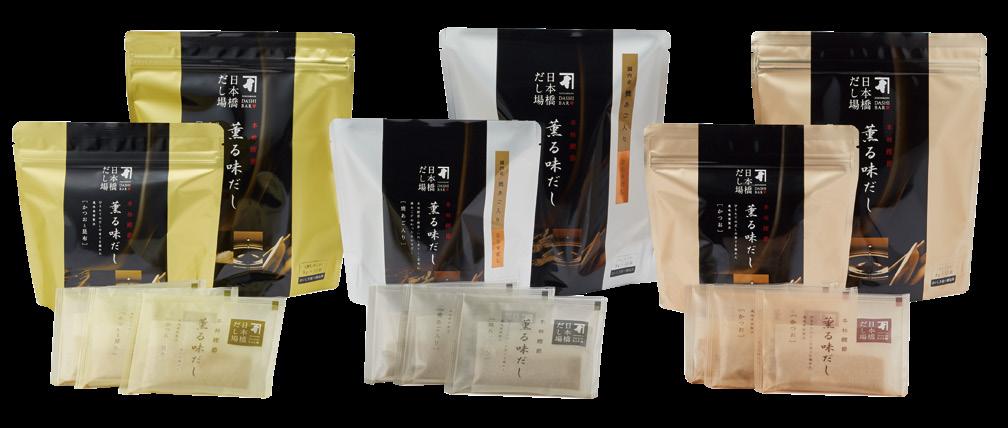
NINBEN にんべん日本橋本店 Established in 1699, NINBEN is known as the originator of Japanese flavors. Now you can recreate these flavors at home with handy flavoredsoups and seasonings sold at this shop, which also make great souvenirs. At Nihonbashi Kezuriba, you can see how professionals shave bonito tuna into flakes during live demonstrations and enjoy the fragrance of freshly cut bonito flakes.
KIYA Nihonbashi Main Store 日本橋木屋本店 Kiya has been specializing in cutlery and knives since 1792, and its shop banner and logo can be spotted in historic art pieces depicting Nihonbashi in 1805. Here you can find traditional handmade knives and knives using modern materials and designs. Unlike Western kitchen knives, there are many unique knives used for different ingredients—be it vegetables, fish or meats. From carbon steel to stainless steel knives, there’s sure to be one that makes the cut.

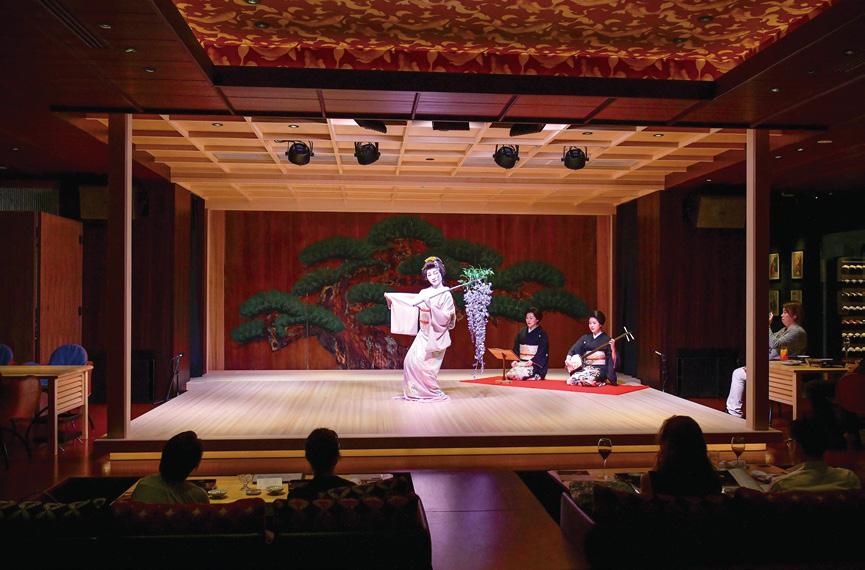
Hanayagi School: Kie Ayaka
SUIGIAN 水戯庵 This theater-themed restaurant and bar proposes a whole new dining experience, offering classy Japanese banquet cuisine alongside live performing arts such as noh, kyogen, nihonbuyo dancing and other traditional Japanese theater. The interior is elaborately designed to reflect the elegance and grandeur of Japanese arts, creating an extraordinary experience full of tastes, smells, sights and sounds.

ShinNihombashi Station
JR Sobu Line
AREA MAP
Mikado Coffee Nihonbashi Honten ミカド珈琲店日本橋本店 More than 70 years ago, Mikado Coffee opened its doors to a stream of Japanese customers craving for a cup of freshly brewed, hot coffee. The coffee connoisseur since then have been roasting imported coffee beans in house to suit the local tastes hence 1948. Their house blend is a well-balanced mild coffee with a hint of sourness which became the most sought after drink until now. Located in Nihonbashi, the main branch was the first shop in Japan that served coffee to standing customers. It’s definitely worth a visit if you are a coffee aficionado, per se.
The Road Origin Marker of Japan & Monument of Nihonbashi Fish Market 日本国道路元標と日本橋魚市場発祥の地碑 Nihonbashi was first commissioned by Ieyasu Tokugawa as part of a national roadway network and served as the starting point for five highways connecting Edo with other areas of Japan. Although it underwent several renovations, the stone bridge built in 1911 still links Tokyo with the suburbs. With seven highways originating here, there is a plate marking this area as ”Kilometer Zero.” Before moving to Tsukiji after a fire triggered by the Great Kanto earthquake in 1923, Tokyo’s bustling fish market was also situated in Nihonbashi. A monument is set up to commemorate this history.
Mitsukoshimae Station
Scan the QR code for more information about the featured places in Nihonbashi
Tokyo Metro Ginza Line
Tokyo Metro Hanzomon Line
Nihonbashi Bridge


黒江屋 Kuroeya A l t h o u g h J a p a n e s e lacquerware is considered to be fine art, it is also widely used by Japanese people daily to boost their aesthetic experience. Kuroeya is a lacquerware shop that was established more than 300 years ago in Nihonbashi from the people of Kuroe Village in Wakayama Prefecture, a well-known producer of lacquerware. Why not get your hands on a lacquerware dish or bowl for either decorative or practical use and bring the essence of Japanese culture into your life?


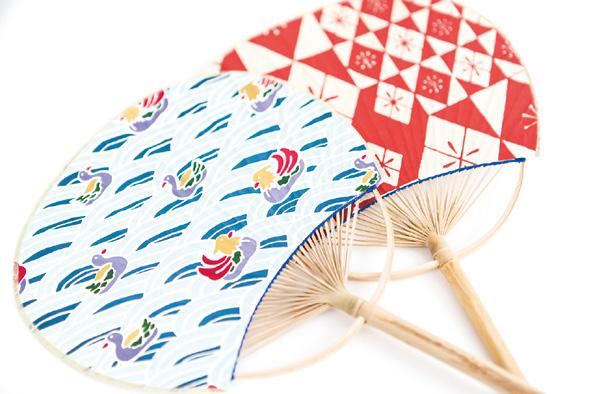
Haibara 榛原 For more than 200 years Haibara has been specializing in traditional and modern washi, Japanese paper products. One of their best-sellers is the Japanese round paper fan, a must-have item to beat the summer heat since the Edo period. Even the members of the British rock band Queen are said to have decorated their interiors with Haibara products.






